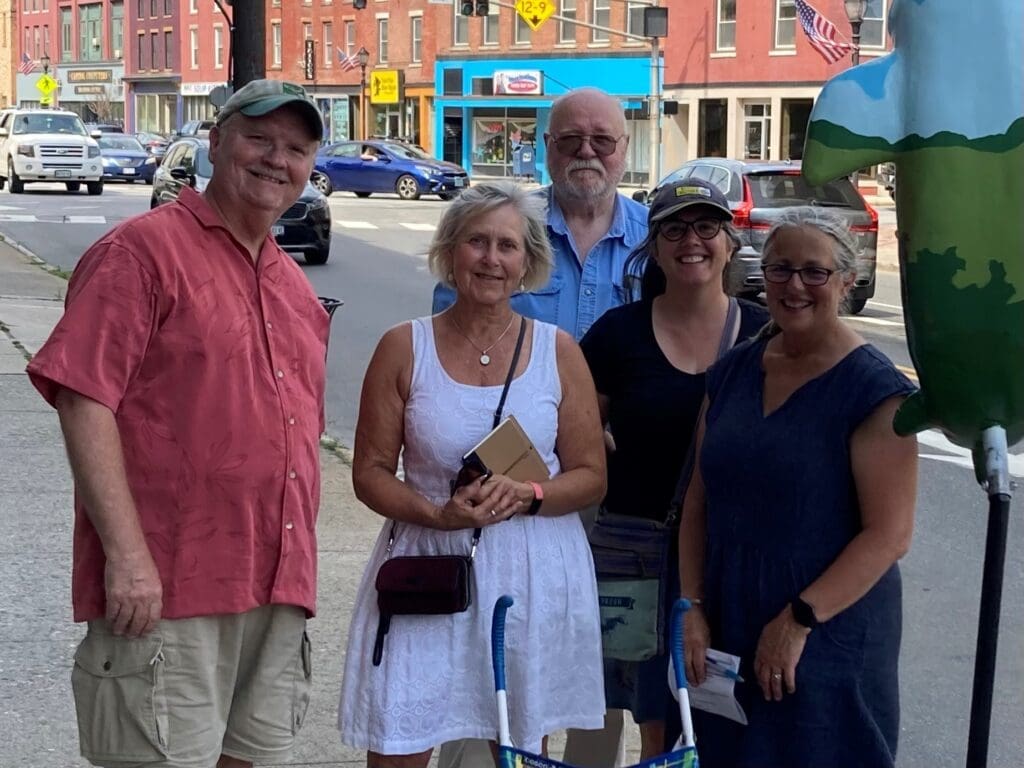Two former Walking College Fellows share their unique collaborative efforts across sectors

By Anne Ball and Dawn Littlefield-Gordon
Dawn Littlefield-Gordon and Anne Ball are always looking for ways to collaborate between their two lines of work- public health and economic development. In 2021, America Walks and AARP Maine brought the Walking College to the State of Maine, and Dawn and Anne were both accepted into the program. Together, they wanted to support the statewide Active Communities Environment Working Group (ACEWG), a cross-sector group convened by the state’s Obesity Prevention Program within the Maine Center for Disease Control and Prevention with no direct funding, that meets to collaborate on how to make Maine more active and safer for physical activity.
This group assists in informing Dawn’s work as the Obesity Prevention Program Manager and Anne’s work as the Sr. Program Director of the Maine Downtown Center, the statewide coordinator for the National Main Street Program, housed at Maine Development Foundation, a nonprofit economic development organization. The Maine Downtown Center supports downtown revitalization, including historic preservation, small businesses, sound design, trail connectivity, wayfinding, downtown events, safe streets, and creating places people want to live and visit.
A New Survey
Anne and Dawn felt the ACEWG needed a renewed and revised direction for their work. It had been a few years since this group had collected data from their stakeholders or had had funding for direct service programming, education, technical assistance, or surveys. The last statewide study targeted at known local Active Community Environment Teams (ACETS) was in 2020.
Anne and Dawn believed that the landscape had changed through the pandemic and that reestablishing communication by conducting an outreach survey with the stakeholders would yield benefits for continuing to support their efforts. This would provide an updated baseline and necessary data to drive the future work of the ACEWG. They also hoped that casting a wider net statewide to the work to support active living was needed. The survey tool was disseminated to various stakeholders, including local ACETS trail groups, public health organizations, transportation non-profits, land trusts, walking and cycling groups and committees, age-friendly groups, and downtown organizations.

Anne and Dawn pieced together funding for the survey through their Walking College Mini-grants, AARP Maine Sponsorship, America Walks Community Change Grant, and general operating from Anne’s organization, Maine Development Foundation. The investment in this work allows the ACEWG to have concrete data and direction for future funding proposals responding to what is needed in Maine. The responses will inform the future work of the ACEWG.
Conducting the Survey
Hart Consulting was hired as the project consultant to develop the survey and collect and analyze the results. The response rate was lighter than hoped but mirrored the results from the 2020 survey. There were 56 responses from 10 of 16 Maine counties, and the effects will be beneficial. Two-thirds of respondents said that their groups address accessibility and age-friendliness so making active living accessible and safe for a wide range of people is a top issue for respondents. Some other significant takeaways were that more than half of the respondents indicated they were part of age-friendly groups. Over one-third said their groups had representation from businesses, bicycle-pedestrian committees, and parks and recreation department staff.
Interestingly, few respondents indicated that youth or youth-serving organizations are represented in their groups. The ACEWG identified this as an opportunity and will look to add youth-serving organizations to the group. Specifically, groups are interested in learning more about traffic calming (almost half of the respondents), including physical design and other measures to improve safety for motorists, pedestrians, and cyclists, all with a goal to combat speeding and other unsafe driving behaviors. Other priorities are building community support and funding sources and choosing strategies that are feasible and impactful. 85% of respondents are interested in technical assistance from the ACEWG! That says the ACEWG has their work cut out for them!
Next Steps
What’s next? We will identify resources, including funding, to provide the training and technical assistance we heard the local groups are interested in and need to do their work more effectively. Anne and Dawn are optimistic that working across public health and economic and community development sectors opens more doors for funding, allowing for broader community engagement and a more substantial community consensus. It also opens the doors to different funding opportunities that one of them could not do alone.